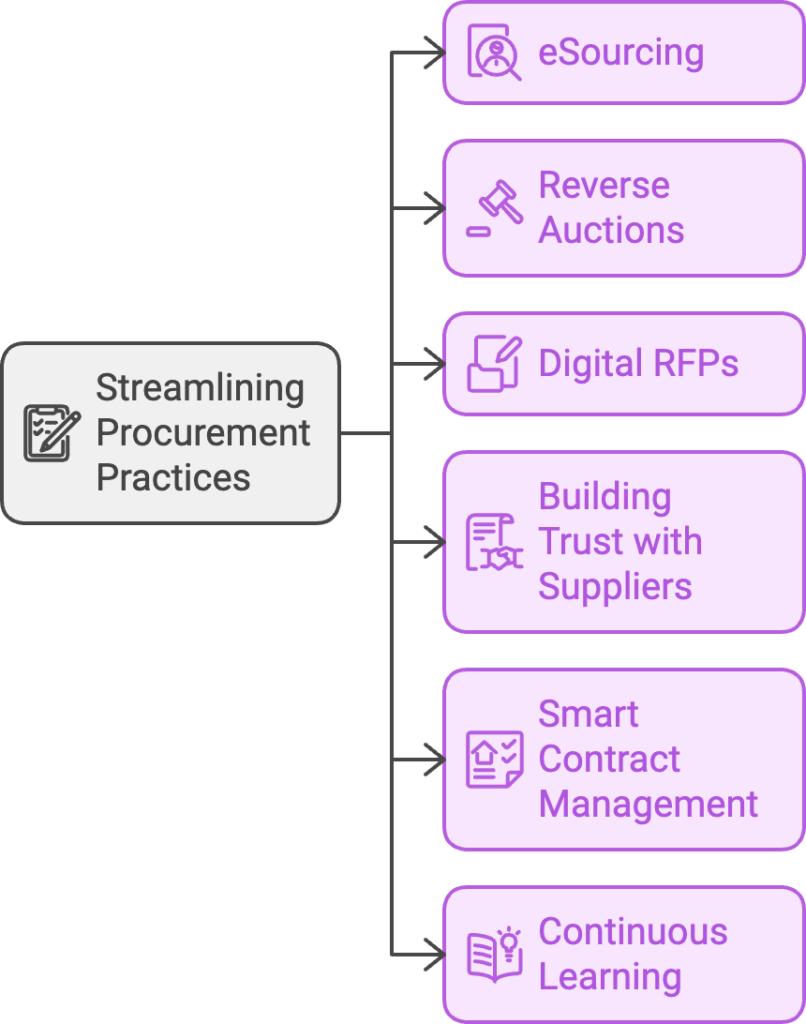Procurement can be challenging, but it doesn’t have to be. By integrating contract management and supplier relationships, businesses can streamline their purchasing processes. Let’s explore how to achieve this.
Key Takeaways
- eSourcing improves transparency and efficiency in procurement
- Reverse auctions can lead to significant cost savings
- Digital RFPs streamline the proposal process
- Building trust with suppliers results in better deals
- Smart contract management software enhances overall procurement
- Continuous learning is crucial for procurement success

Get to Know eSourcing
eSourcing is like online shopping for businesses. It helps companies find and buy what they need more easily. With eSourcing, everything’s out in the open, so everyone knows what’s going on. It’s also great for teamwork – people from different departments can work together to make smart choices.
Here’s what makes eSourcing cool:
Key Benefits of eSourcing
- Increased Transparency
- Improved Supplier Management
- Cost Savings through Competitive Bidding
- Faster Procurement Cycle Times
- Enhanced Team Collaboration
eSourcing isn’t just about buying stuff online. It’s about making the whole process of finding suppliers and getting what you need smoother and smarter. By using eSourcing, companies can reduce procurement costs by up to 15% and cut cycle times by 50% or more. This digital approach also allows for better data analysis, helping businesses make more informed decisions about their suppliers and purchases.
Try Reverse Auctions
Imagine an auction, but backwards. That’s a reverse auction. Instead of buyers competing to pay more, suppliers compete to offer the lowest price. It’s a great way for businesses to save money.
Reverse auctions work best when:
- There are lots of suppliers who can give you what you need
- You’re buying things that aren’t super complicated
- You know how much you should be paying
When done right, reverse auctions can save companies between 18% and 40% on what they buy. That’s a lot of money! For example, a manufacturing company might use a reverse auction to source raw materials, potentially saving millions on their annual spend. It’s important to note that reverse auctions aren’t just about getting the lowest price – they can also help identify the most efficient suppliers and improve overall supply chain performance.
Make RFPs Digital
RFP stands for “Request for Proposal.” It’s like asking suppliers, “Hey, what can you offer us?” Making RFPs digital is smart because:
- It’s faster to create and send out RFPs
- You can reuse templates, so you don’t have to start from scratch each time
- It’s easier to compare different offers
- You can keep track of everything better
Digital RFPs help you manage suppliers better and often lead to bigger savings. Plus, if anyone ever needs to check what happened, all the info is right there, easy to find. Digital RFP management can reduce the time spent on creating and evaluating proposals by up to 40%, allowing procurement teams to focus on more strategic tasks.
Learn more about digital RFPs and how they can make your procurement process smoother. By digitalizing RFPs, companies can also improve the quality of responses from suppliers, as the structured format ensures all necessary information is provided upfront.
Build Trust with Suppliers
Good relationships with suppliers are super important. Here’s how to build trust:
- Be clear about what you need
- Only invite suppliers who can really do the job
- Tell suppliers exactly how you’ll choose the winner
- Don’t change the rules after the bidding starts
- Talk to suppliers who bid too high or too low to understand why

When suppliers trust you, they’re more likely to give you their best offers. This means better deals for your company. Effective supplier relationship management can lead to a 20% reduction in supply chain costs and a 50% faster time-to-market for new products. Trust also encourages innovation, as suppliers are more willing to share new ideas and technologies with trusted partners.
Use Smart Software
Good contract management software can make a big difference. Look for software that:
- Ensures security and compliance
- Provides automated alerts
- Offers workflow automation
- Includes reporting and dashboard features
- Acts as a contract repository
With the right software, you can keep track of contracts easily, spot opportunities to save money, and make sure you’re following all the rules. Effective contract management can reduce administrative costs by up to 30% and increase contract renewal rates by 25%. It also helps in identifying cost-saving opportunities and reducing compliance risks.
Keep Learning and Improving
The world of procurement is always changing. To stay on top of things:
- Keep an eye on market trends
- Ask different teams in your company what they need
- Look at data to see what’s working and what’s not
- Be open to trying new ways of doing things
By always looking for ways to get better, you can make sure your procurement process keeps up with what your business needs. Staying updated on procurement trends can help you identify new technologies and strategies that can further optimize your processes. For instance, AI and machine learning are increasingly being used in procurement to predict demand, optimize inventory, and identify potential supply chain disruptions before they occur.
Wrapping Up
Bringing together contract management and supplier relationships isn’t just about saving money (though that’s a big plus). It’s about making the whole process of buying things for your business smoother, faster, and smarter. By using tools like eSourcing, reverse auctions, and digital RFPs, and by building strong relationships with suppliers, you can take your procurement game to the next level.
Remember, the goal is to make procurement work for you, not the other way around. With these tips and tools, you’re well on your way to becoming a procurement pro! Implementing procurement best practices can lead to significant improvements in efficiency, cost savings, and overall business performance. As you continue to refine your procurement strategy, consider exploring spend analysis tools to gain deeper insights into your company’s spending patterns and identify additional areas for optimization.



